 |
On December 26th, 2004, over 35,000 people perished during the catastrophic tsunami that hit the coasts of the North-East and South of the island of Sri Lanka.
The United Nation High Commission for Refugees (UNHCR) said five days after the disaster that almost two thirds of those killed were in the Tamil homeland of the North-East.
 |
"The North-East is the region worst affected by the tsunami," the World Bank, Asian Development Bank (ADB) and Japan Bank for International Cooperation (JBIC) said in a joint report.
Within hours of the waves striking the coastline, the Liberation Tamil Tigers of Tamil Eelam (LTTE) had issued an urgent appeal for international assistance, declaring the situation as a National Emergency.
“It is ironical that this tragedy had befallen on a people who suffered the brutality of a war for two decades and are continuing to exist without realising the basic dividends of peace, normalcy,” said the LTTE, adding “the human disaster and the tragedy the survivors face are unprecedented and need immediate and effective humanitarian intervention.”
The Tamil Rehabilitation Organisation (TRO), the following day, released an appeal to the international community listing urgent requirements that needed to be attended to.
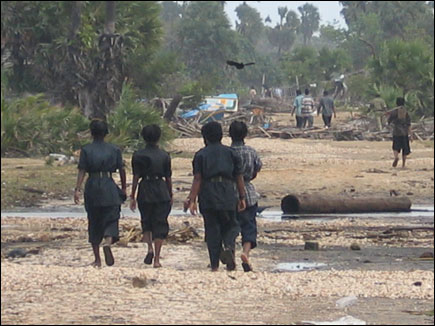 |
| Photograph:TamilNet |
LTTE provides immediate relief, Tamil diaspora ships in aid and SL government fails to act
The day after the devastating waves, the current president Mahinda Rajapaksa (then prime minister) called an 'urgent disaster management' meeting that was attended by political parties from all regions, including the Tamil National Alliance (TNA).
Despite the Tamil regions being most affected, the meeting's focus was on the devastation in the Sinhala south.
"The devastation and destruction in the North-East was discussed for not more than five minutes during the two hour conference," said a TNA MP that attended the event, Joseph Pararajasingham.
"In fact the situation in the North-East was only taken up after I raised the issue. They are simply not bothered to talk about the plight of our people," he added.
Almost exactly one year later, Pararajasingham was assassinated as he attended Midnight Mass at St Mary's Church in Batticaloa. Two gunmen walked into the church and opened fire, killing the MP and wounding eight others, including his wife.
On Dec 30 2004, the Jaffna based newspaper, Uthayan, in its editorial said,
"Though it is now three days since... the heart melting tragedy, the situation reports received from many parts of the North-East show that no relief from the Sri Lankan government reached them as yet."Immediate aid was provided to those affected in the North-East by the LTTE functioning on its own reserves, followed by a swift an extensive programme of post-tsunami relief effort, together with the contribution of the Tamil diaspora through organisations such as the Tamil Rehabilitation Organisation (TRO).
 |
| Photograph:Tamilnation.co |
Describing the rescue effort in the LTTE controlled areas, the Associated Press reported:
“Within minutes of the disaster, soldiers of the LTTE were evacuating survivors and pulling bodies from the still-roiling water. In a well-practiced drill, squads set up roadblocks to control panic and prevent looting. Others requisitioned civilian vehicles to move the injured to hospitals. Many donated blood. Teams with digital cameras and laptops moved into disaster zones to photograph the faces of the dead for later identification, then swiftly cremated or buried the corpses. By the end of the first day, the first refugee centers were set up. Meanwhile, in the south, the government was struggling to cope while politicians argued over who was in charge. From the field came isolated reports of corruption and hijacking of relief trucks."
On Jan 04 2005 the Italian Foreign Ministry, handed over aid to the LTTE, for distribution via relief centres in LTTE controlled territory.
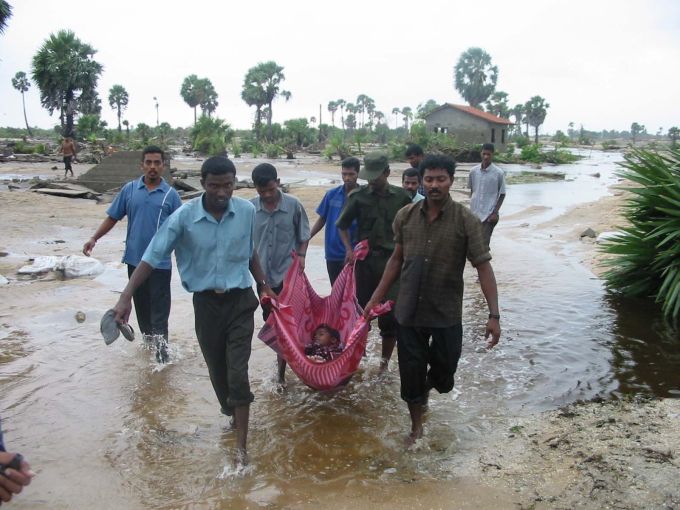 |
| Photograph:Tamilnation.co |
The Tamil Rehabilitation Organisation (TRO), within two weeks of the disaster, had set up trauma clinics for survivors of the tsunami.
On Jan 06 2005, TNA MPs and the LTTE navy commander rejected directives from the government ordering that victim relief centres run by local Tamils and the LTTE within Sri Lankan army controlled areas should be handed over to the Sri Lankan army.
The tragedy spurred Tamils across the world to act. By 30 Jan 2005, members of the Tamil diaspora in the US state of Washington, managed to organise the shipping of 3,200 cubic feet of relief aid, including food and medicine, to the North-East using the Tamil Rehabilitation Organisation (TRO).
Government stops UN Secretary General Kofi Annan from visiting North-East
Following the disaster, on January 8, 2005, the UN Secretary General, Kofi Annan, visited the island to inspect the devastation himself.
However, despite the North-East being the worst-affected region, the UN official was prevented from visiting the Tamil areas.
CNN reported that the Sri Lankan government, led by then president, Chandrika Kumaratunga, refused to allow the UN Secretary General’s wish to visit LTTE controlled territory.
"Sri Lanka's government has stopped visiting U.N. Secretary-General Kofi Annan from touring tsunami-ravaged areas controlled by its Tamil Tiger rebel foes, despite his requests," reported Reuters.
The government's refusal to allow him to visit the Tamil areas, came despite numerous calls from the LTTE, Tamil politicians and civil society organisations calling on Mr Annan to visit.
On Jan 07 2004, Catholic leaders in the North-East wrote to the UN Secretary General “humbly requesting the Secretary General Kofi Annan to visit the affected parts in the north and meet LTTE leaders and discuss with them about the future rehabilitation of the Tsunami victims.”
Tamils call for international relief mechanism to ensure aid to North-East, Tamil political leaders assassinated
 |
| Photograph:TamilNet |
Roughly a month after the tsunami, on Jan 28, complaints of the failure of the Sri Lankan government to provide aid relief to the North-East continued.
A school principal, running a relief centre in Batticaloa, said that internally displaced people (IDPs) in the district had not received food or any other relief from the government.
As it continued to become clear that the North-East was suffering at the Sri Lankan government’s centralisation of tsunami relief efforts, the Tamil National Alliance (TNA) in a meeting with the foreign minister of the Netherlands, called for a separate international relief mechanism for the North-East.
"The continuance of the present method of function could only result in further deterioration, and that it was imperative that the government urgently set up the required mechanism in the North-East," the TNA warned.
The relief efforts for the Tamil people suffered a further set back however, when on February 7, 2005, a former TNA MP, Chandranehru Arianayaam, and the head of the LTTE Batticoloa-Amparai political division, E. Kousalyan, were killed in an ambush by government forces. He was returning to Batticaloa from a district meeting on post-tsunami relief, rehabilitation and reconstruction in Kilinochchi.
Speaking on the death of the former TNA MP, the LTTE said,
“Former Amparai District parliamentarian and human rights activist who was travelling with Kaushalyan (LTTE political head) is an irreparable loss to the Tamil people at this time. Being a founder member of the North-East Secretariat on Human Rights (NESOHR), Mr Chandranehru Arianayaam functioned vigilantly in the area of human rights violations in his district.”“We thought the Tsunami disaster which killed Tamils, Muslims and Singhalese, regardless of their race and class, would have driven some sense into Sinhala political leaders. Kousalyan's murder shows they have not changed. They are still intent on crushing the Tamil nation by foul means", said a senior LTTE leader at the funeral of those killed in the ambush.
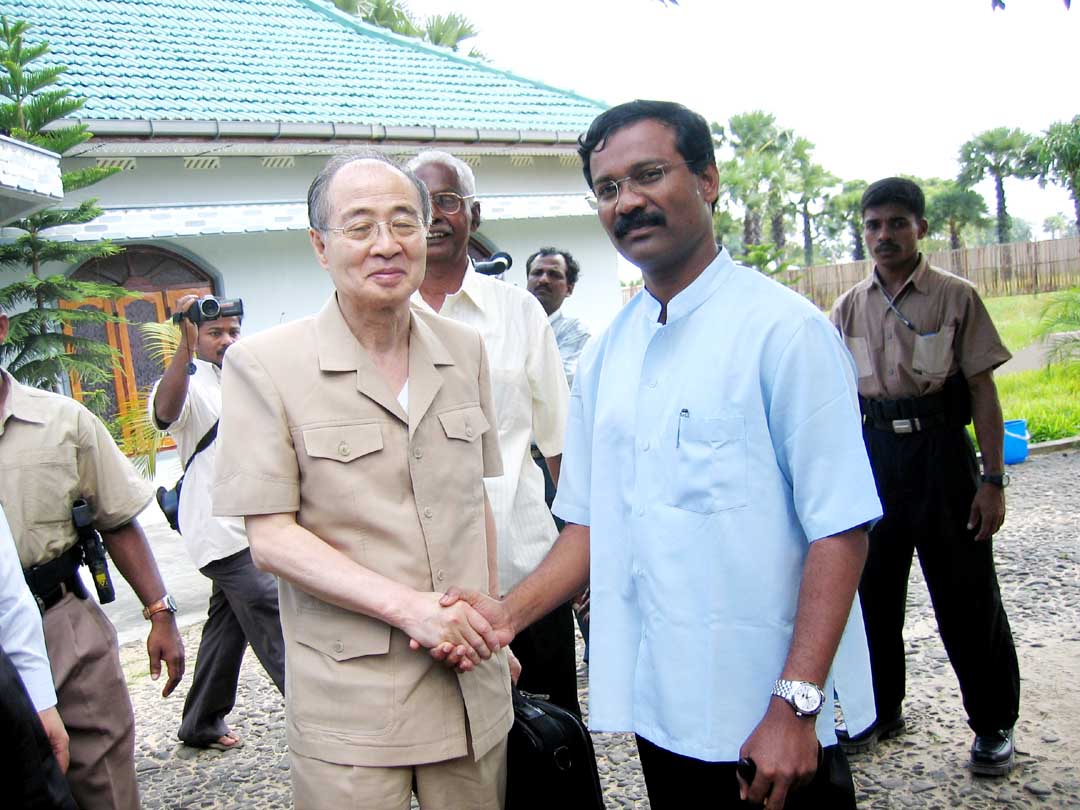 |
| Photograph:TamilNet |
The assassinations were in violation of the 2002 Ceasefire Agreement (CFA) between the LTTE and Sri Lankan government.
Japan's Special Peace Envoy, Yasushi Akashi, after meeting senior LTTE officials and TNA MPs to discuss relief needs of the North-East, added that the killings of LTTE political figureheads had “poisoned the cease fire atmosphere.”
Speaking at a rally with TNA MPs on the recent political killings and consequential clamp down on civilian dissent, the Bishop of Mannar, said, “there is nothing wrong with the Tamil nation raising its national flag. It is very deplorable that such murders are committed even amidst the great human tragedy caused by the Tsunami."
"These killings are provocations to war. I praise the Tigers for being patient despite such provocations. It appears that some sections are intent on pushing the peace process backwards," the bishop added.
Tamil civilian unrest over political assassinations, EU calls for establishment of joint tsunami aid mechanism between SL and LTTE
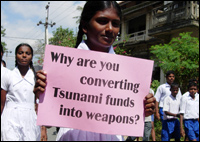 |
| Photograph:TamilNet |
The continued neglect of the North-East resulted in protests in Jaffna. On 02 March 2005, over 20,000 people, condemning the killing of LTTE political heads, staged demonstrations urging the international community to persuade the Sri Lankan government to restart stalled peace-talks with the LTTE and set up a mechanism with the LTTE for equitable distribution of tsunami aid to the North-East.
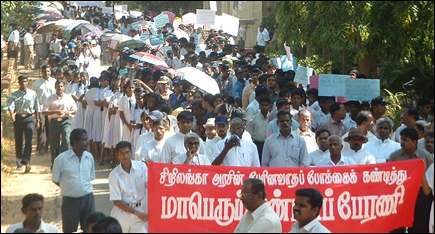 |
| Photograph:TamilNet |
The European Unions Commissioner for External Relations, Benito Ferroro Waldner, on 08 March 2005, called on the government, the LTTE and the opposition to establish a joint mechanism for distributing aid.
The LTTE political head, S. P. Thamilselvan, in a meeting with Swedish officials and the EU deputy director for external relations later that month accepted the EU calls. The Sri Lankan government remained reluctant to accept the joint mechanism proposal.
Highlighting the government's reluctance, Mr. Thamilselvan said, although the proposed joint mechanism for post-tsunami rehabilitation and reconstruction did not fully meet the requirements necessary to facilitate recovery efforts in North-East to proceed unhindered, the LTTE accepted the proposal in view of the urgency demanded by the situation in North-East.
SL fails to yield to joint aid mechanism discussion, illustrious Tamil political journalist assassinated
Amid assassinations of Tamil politicians, and discussions on the international proposal for a joint aid distribution mechanism as well as how to reignite peacetalks between the LTTE and Sri Lankan government, came the assassination of a key Tamil journalist and political commentator.
In April 2005, Dharmeratnam Sivaram, was abducted in front of a police station. He was found murdered the following day.
“The Committee to Protect Journalists condemns the brutal killing of leading Tamil journalist Dharmeratnam Sivaram, who was abducted yesterday and found dead this morning near the capital, Colombo, from gunshot wounds to the head,” said the New York Based organisation adding, that “the brazen abduction and execution of a veteran journalist sends a chilling message to others in the Tamil media.”
LTTE calls for pressure on SL to negotiate, TNA excluded from parliamentary tsunami aid discussions, embargo placed on LTTE territory
In May 2005, the TNA leader, R Sampanthan, meeting with India’s foreign secretary, said that negotiations to further the peace process were failing, as even a joint tsunami aid mechanism could not be agreed by the Sri Lankan government.
The LTTE’s chief negotiator, Anton Balasingham, in a meeting with Norwegian diplomats, welcomed the international donor community’s commitment to a joint aid mechanism and called for further pressure on Sri Lanka’s president, Chandrika Kumaratunga, to assure that she would overcome opposition within her government, and sign an agreement with the LTTE.
Sri Lanka “must engage seriously with the LTTE in finalising the terms of the joint mechanism and sign the agreement to enable aid to flow to the North-East,” Balasingham was quoted as saying at the time.
Despite international pressure on the Sri Lankan government however, the TNA was excluded from a parliamentary development meeting on the relief effort.
Condemning the government actions, the TNA leader, R Sampanthan, writing to the Sri Lankan government, said,
“The Tamil-speaking people of the North East have been denied the opportunity of having their views presented at these sessions. Your conduct is however consistent with other actions of the Sri Lankan State in the recent Post Tsunami phase, when several world leaders despite their anxiety to do so, were denied the opportunity to visit the affected areas in some parts of the North-East, and gain first hand knowledge of the real situation.”
Incredulously, whilst negotiations on aid distribution to the North-East continued, an economic embargo was placed on the Batticaloa and Vaharai regions.
On 31 May 2005, over 3,000 residents staged a protest, demanding that the Sri Lankan army’s blockade of cement, fuel, building materials and other essential items to villages located in LTTE territory be lifted.
Negotiations with Sri Lanka fail
The Tamil people and the LTTE, from the onset, had low expectations of seeing international aid that was given to the Sri Lankan government ever reaching the worst affected Tamil regions of the island.
Indeed whilst billions of dollars of official foreign aid was pledged for Sri Lanka, very little trickled through to the North-East. International aid was blocked and diverted to the south. Aid from the Tamil Diaspora was also blocked and sometimes appropriated.
The LTTE political wing was meeting missions worldwide in an attempt to secure an international mechanism that guaranteed that international tsunami aid funds be allocated across the island proportionately.
An agreement to jointly distribute $3 billion of aid, the P-TOMS, was scrapped just months after the disaster, when Sri Lanka’s new president Mahinda Rajapaksa took charge.
The TRO, in a statement released a year after the disaster, blamed the Sri Lankan government and said the North-East had seen a much slower recovery in comparison to the south of Sri Lanka.
Disproportionate allocation of governmental resources to the North-East, Colombo's rejection of a landmark aid sharing and management structure (P-TOMS), the centralisation of bureaucracy and a slower rate of fund disbursement to tsunami affected people in the North-East, were all listed by the TRO as key structural failings of the Sri Lankan state that had obstructed post-tsunami development in the North-East.
"The difficulties that NGOs have in working in the North-East due to government restrictions, regulations and harassment," the TRO said, pointing out that there
were fewer international NGOs (per capita) in the North-East than the South.
A year on, over 80% of the tsunami victims in the North-East remained homeless.
Over 3 years after the tsunami, a NGO Action Aid, in a report titled 'Voice from the Field,' said "not even 12 percent of fully damaged houses in the north have been rebuilt."
The findings came as a Sri Lankan cabinet spokesperson, Anura Priyadharshana, boasted that almost 100 percent of the houses damaged by the tsunami had been rebuilt.
In fact, in Rajapaksa’s home city in Hambantota, nearly 3,200 excess houses were built and were occupied by those not affected by the tsunami.
Five years after the disaster, in December 2009, Transparency International, said that nearly half a billion dollars given to Sri Lanka in tsunami aid was unaccounted for, whilst a further $600 million had been spent on projects unrelated to the disaster.
11 years on
As the world marks 11 years since the devastation caused by the tsunami, the Tamil nation continues to recover from state-sponsored destruction and survive ongoing oppression in the North-East of Sri Lanka. Since the waves struck, tens of thousands of Tamils have been slaughtered at the hands of the Sri Lankan state and attempts at international isolation of the North-East continue.
Whilst most of the areas affected by the tsunami reflect on how they have recovered from the catastrophic event a decade ago, Tamils in the North-East continue to struggle for aid, political rights, accountability and justice against unchanged waves of destruction from a chauvinistic Sinhala state.
Related articles:
North-East remembers victims of 2004 tsunami (26 Dec 2014)
Canadian Tamils remember Boxing Day tsunami (26 Dec 2014)
Tamils in Germany remember tsunami victims (27 Dec 2014)
